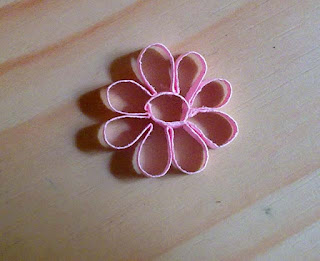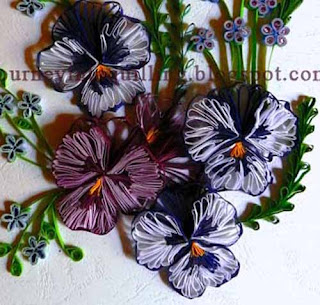This saves the hazzle of quilling each petal separately and pasting. Furthermore, it is very stable once the glue dries and holds the shape well unless you squash it too much.
SINGLE STRIP FLOWER
Make a scalloped strip as per my tutorial here. first scallop should be long enough to make a circle and glue. The other scallops should be long enough to make petals with.
Now make a circle around a cylindrical object like a pencil and glue it.
Apply a tad of glue to the next fold. Apply to the mountain fold side. ( when you fold paper one side is called the valley side the other side will be the mountain side).
Paste it to the circle as shown above.The distance is determined by the no of petals you require. If you can achieve outdistance you will get a perfect flower. ( the circle is the most stable geometrical shape in nature as you know).
Continue the same procedure till you come to the last petal. Cut a bit beyond the fold as shown above and apply glue to the mountain and the underside of the extra bit anf glue it to the circlr and the adjoining petal.
You're done!! shape the circle by inserting a pencil and get the flower into proper shape.
MULTI-STRIP FLOWER
Prepare a scalloped multi strip as shown above. This flowers is going to be made without a centre.
Apply glue to the mountain fold side as shown above but apply to both sides and not on the fold itself as you are going to paste petal to petal'
Glue as shown to create the petal.Continue the process glueing the petals around till you complete the flower. You will need to arrange the petals into a circle and glue as in the flowers below. If required apply a tad of glue to the center to hold all the petals together.























































